
The decisive year was 1968. In the early morning of 30 January, Vietcong forces launched the Tet Offensive, named for the Vietnamese holiday then being observed.
In coordinated attacks throughout South Vietnam, the Vietcong assaulted major urban areas and military installations in an attempt to spark a popular uprising against the Saigon regime and its American backers.
(Note: the other part of this photo collection: Vietnam War: The Early Years through rare photographs, 1965-1967).
Heavy fighting ensued for three weeks, some of the most brutal at Hué. Westmoreland claimed victory because no cities were lost and thousands of casualties were inflicted upon the attackers.
Indeed, the Vietcong lost so many soldiers that thereafter the PAVN took over much of the conduct of the war.
The Tet Offensive, however, was a great strategic gain for North Vietnam and its southern adherents. U.S. and ARVN losses were high, and the fighting generated thousands of refugees that further destabilized the South.
Most importantly, as a result of the massive surprise attack and the pictures from Saigon, the U.S. press and public began to challenge the Johnson administration’s assurances of success and to question the value of the increasingly costly war.

U.S. air policemen take cover and leave their jeep as they come under sniper fire near Da Nang Airbase in Vietnam on January 30, 1968, after it was hit by a rocket barrage. Flares light up the Da Nang area to make it easier to spot infiltrating guerrillas.
At the same time as the Tet Offensive, the siege of Khe Sanh underscored the image of the war as an endless, costly, and pointless struggle.
From 20 January to 14 April 1968, 30,000 to 40,000 NVA forces surrounded 6,000 U.S. Marines and ARVN at the remote hilltop outpost of Khe Sanh in the northwest corner of South Vietnam.
Using artillery and airpower, including B‐52 strikes, the United States eventually broke the siege and forced an NVA withdrawal.
At the end of June, however, the Marines abandoned the base to adopt a more mobile form of fighting in the DMZ area. Once again, a major engagement left seemingly intangible results.
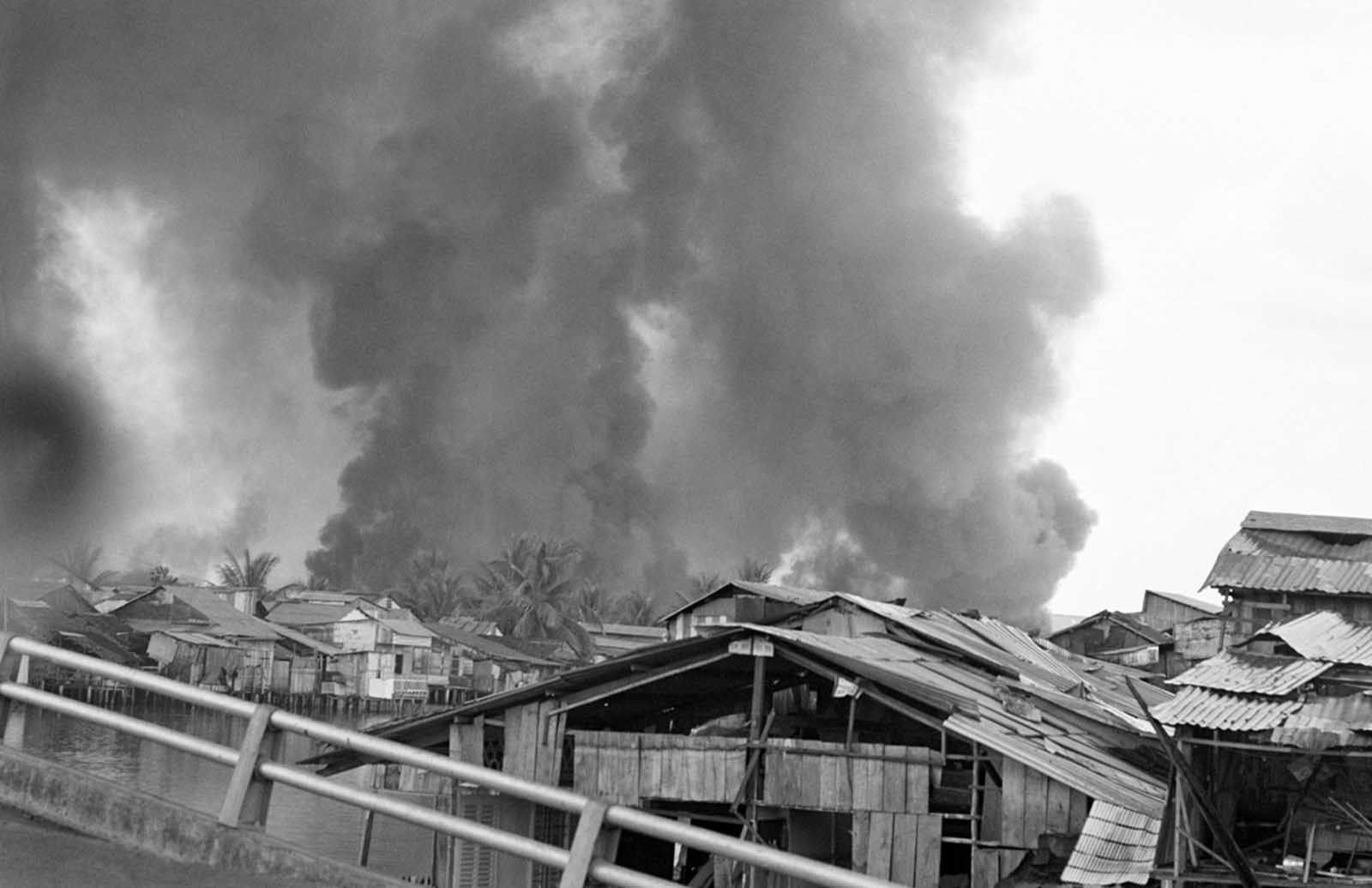
Battle of Saigon, First Offensive, on February 10, 1968
In March 1968, Johnson decided that the size of the U.S. effort in Vietnam had grown as large as could be justified.
Prompted by a request from Westmoreland and JCS Chairman General Earle G. Wheeler for 206,000 more men, the president asked his new secretary of defense, Clark Clifford, for a thorough policy review.
Johnson’s sense that a limit had been reached seemed confirmed when the “Wise Men,” a group of outside advisers including such elder statesmen as former Secretary of State Dean Acheson and Gen. Omar Bradley, recommended against further increases.
The president authorized only 13,500 more soldiers and bluntly informed Thieu and Ky that their forces would have to carry more of the fighting.
He then announced on television on 31 March 1968 that the United States would restrict the bombing of North Vietnam and pursue a negotiated settlement with Hanoi. Johnson also revealed that he would not seek reelection.

The flag of the Republic of Vietnam flies atop a tower of the main fortified structure in the old citadel as a jeep crosses a bridge over a moat in Hue during the Tet Offensive, February 1968.
Meanwhile, combat raged in South Vietnam. Over 14,000 Americans were killed in action in Vietnam in 1968, the highest annual U.S. death toll of the war.
The worst U.S. war crime of the conflict occurred on 16 March 1968 (although not revealed in the press until 6 November 1969) when American infantrymen massacred some 500 unresisting civilians, including babies, in the village of My Lai.
In April and May 1968 the largest ground operation of the war, with 110,000 U.S. and ARVN troops, targeted Vietcong and NVA forces near Saigon.
Peace talks began in Paris on 13 May but were immediately deadlocked. On 10 June 1968, Gen. Creighton Abrams succeeded Westmoreland as MACV commander.
In the fall Abrams began to shift U.S. strategy from attrition to a greater emphasis on combined operations, pacification area security, and what was called “Vietnamization,” that is, preparing the ARVN to do more of the fighting.

A dead civilian lies nearby as a young Vietnamese boy shields his ears from gunfire blasts and runs for cover on a Da Nang street on January 31, 1968.
When Richard M. Nixon became president in 1969, the U.S. war effort remained massive, but the basic decision to de‐escalate had already been reached. Nixon owed his political victory to voter expectation that somehow he would end the war.
He and his principal foreign policy adviser, Henry Kissinger, rejected precipitate U.S. withdrawal. With the ground war stalemated, the new administration turned increasingly to air bombardment and secretly expanded the air war to neutral Cambodia.
Publicly the White House announced in June the first withdrawal of 25,000 U.S. troops and heralded Vietnamization as effective. In fact, South Vietnam’s armed forces remained problem‐plagued.
To bolster the South, the administration leaked to the press dire threats of a “go for broke” air and naval assault on the North—possibly including nuclear weapons.
Kissinger also began secret meetings with North Vietnamese representatives in Paris hoping to arrange a diplomatic breakthrough.

U.S. Marines and Vietnamese troops move through the grounds of the Imperial Palace in the old citadel area of Hue, Vietnam, on February 26, 1968, after seizing it from Communist hands. The heavy damage was the result of the artillery, air, and mortar pounding the area received for 25 days while the Viet Cong/NVA held the area.
The morale and discipline of U.S. troops declined in 1969 as the futility of the ground war and the beginnings of U.S. withdrawal became more obvious.
After an intense ten‐day battle in May, infantrymen of the 101st Airborne Division (Air Mobile) took a ridge in the A Shau Valley that they had dubbed Hamburger Hill.
Having fought bravely and suffered significant losses, the soldiers were bitter when the site soon was abandoned.
Such inability to see progress, and awareness among the troops that politicians back home were giving up on the war, helped undermine military effectiveness.
Simple survival of their twelve‐month tour of duty became the only motivation for many soldiers.
Incidents of insubordination, mutiny, fatal assaults on officers, drug use, racial tensions, and other serious problems increased.

With dead U.S. soldiers in the foreground, U.S. military police take cover behind a wall at the entrance to the U.S. Consulate in Saigon on the first day of the Tet Offensive, January 31, 1968. Viet Cong guerrillas had invaded the grounds of the U.S. embassy compound in the earliest hours of the coordinated Communist offensive.
Faced with mounting public dissatisfaction, the slow pace of Vietnamization, and diplomatic frustration, Nixon boldly sent U.S. units into Cambodia in April 1970.
U.S. military leaders had long complained about the sanctuary that neutral Cambodia provided Vietcong and NVA forces.
This Cambodian incursion lasted until the end of June and provided some tactical gains, but it also sparked sharp controversy and demonstrations by the Vietnam antiwar movement in the United States over what seemed an expansion of the war to another country.
U.S. troop reductions continued with only 334,600 in the South as 1970 ended.

South Vietnamese combat police advance toward a burning building in northeastern Saigon on February 19, 1968, as they battle Viet Cong forces who had occupied several city blocks in the area.
Nixon stuck with more of the same in 1971. Responding to domestic critics, he continued to order U.S. troops home, leaving only 156,000 by December.
To support Vietnamization, heavy U.S. air attacks continued against Communist supply lines in Laos and Cambodia, and so‐called protective‐reaction strikes hit military targets north of the Demilitarized Zone and near Hanoi and its port city of Haiphong.
Tactical air support continued, with the heaviest coming in March during a South Vietnamese assault into Laos.
Code named Lam Son 719, this operation ended in a confused retreat by the ARVN that further sullied the notion of Vietnamization.

The South Vietnamese General Nguyen Ngoc Loan, chief of the national police, fires his pistol into the head of suspected Viet Cong officer Nguyen Van Lem (also known as Bay Lop) on a Saigon street on February 1, 1968, early in the Tet Offensive. Lem was suspected of commanding a death squad that had targeted South Vietnamese police officers that day. The fame of this photo led to a life of infamy for Nguyen Ngoc Loan, who quietly moved to the United States in 1975, opening a pizza shop in Virginia. Read more about this picture.
During 1971, Kissinger made progress in the secret negotiations by offering to separate the arrangement of a ceasefire from discussion of the future of the Saigon government.
In 1972 Nixon traveled to China and the USSR in diplomatic initiatives, trying to isolate Hanoi from its suppliers.
With the shrinking American forces nearing 100,000 (only a small portion being combat troops), General Giap launched a spring 1972 offensive by Communist forces against the northern provinces of South Vietnam, the Central Highlands, and provinces northwest of Saigon.
In most of the battles, the ARVN was saved by the massive B‐52 bombing. Nixon also launched the heavy bombers against North Vietnam itself in a campaign called Linebacker, and the United States mined the harbor at Haiphong.
Over the course of the war, the total U.S. bombing tonnage far exceeded that dropped on Germany, Italy, and Japan in World War II.

Assault boats in the Mobile Riverine Force of the U.S. 9th Infantry Division glide along the My Tho River, an arm of the Mekong Delta near Dong Tam, 35 miles southwest of Saigon, on March 15, 1968.
Wearied by the latest round of fighting, the United States and North Vietnamese governments agreed in October on a ceasefire, return of U.S. prisoners of war (POWs), at least the temporary continuation of Thieu’s government, and, most controversially, permission for NVA troops to remain in the South. Objections from Thieu caused Nixon to hesitate, which in turn led Hanoi to harden its position.
In December, the United States hit North Vietnam again with repeated B‐52 attacks, codenamed Linebacker II and labeled the Christmas Bombing by journalists.
On 27 January 1973, the United States, North Vietnam, South Vietnam, and the Provisional Revolutionary Government representing the NLF signed the Paris Peace Agreements Ending the War and Restoring Peace in Vietnam, which basically confirmed the October terms.

Police struggle with anti-Vietnam War demonstrators outside the Embassy of the United States in Grosvenor Square, London, on March 17, 1968.
By 1 April 1973, U.S. forces were out of Vietnam (except for a few embassy guards and attaches) and 587 POWs had returned home (about 2,500 other Americans remained missing in action).
Congress cut off funds for the air war in Cambodia, and bombing there ended in August. Over Nixon’s veto, Congress passed the War Powers Resolution in November 1973.
It limited presidential power to deploy U.S. forces in hostile action without congressional approval.

Marine Lance Corporal Roland Ball of Tacoma, Washington, wearing his flak vest, starts the day off with a shave in a trench at the Khe Sanh Base in Vietnam on March 5, 1968, which was surrounded by North Vietnamese regulars. Ball uses a helmet as a sink and a rear-view mirror taken from a military vehicle.
Nixon characterized the Paris Peace Agreements of 1973 as “peace with honor,” but primarily they allowed the U.S. military to leave Vietnam without resolving the issue of the country’s political future.
Without U.S. air and ground support, South Vietnam’s military defenses steadily deteriorated.
In the spring of 1975, an NVA thrust into the Central Highlands turned into an ARVN rout.
On 30 April, as NVA and Vietcong soldiers entered the city, the last remaining Americans abandoned the U.S. embassy in Saigon in a dramatic rooftop evacuation by helicopters.

Vietnamese women on the streets of Saigon, April 1968.
The United States’ failure in Vietnam raised important questions. Should the United States have fought the war at all? Did the United States fight the war the wrong way?
Many analysts believe that the strategic importance of Vietnam was vastly exaggerated and, furthermore, that the nationalism driving Vietnam’s history and politics could not be altered by U.S. military power, no matter how great.
An alternative view is that even if the odds were poor for U.S. success, the United States had to make the effort to maintain its moral and strategic credibility in the world.
On the question of how the war was fought, the debate centers on whether the United States used its military power adequately and effectively.

The bodies of U.S. Marines lie half buried on Hill 689, about two-and-a-half miles west of Khe Sanh, in April of 1968. Fellow Marines stand guard in the background after battling entrenched North Vietnamese troops for the hill.
Assuming that more is better, some critics argue that greater use of U.S. forces, either against North Vietnam or to isolate the battlefield in South Vietnam, would have produced victory.
Throughout the conflict, however, the Saigon regime proved incapable of translating military success into political success.
Also, massive U.S. assistance seemed to prove North Vietnam’s and the Vietcong’s claims that South Vietnam was not a Vietnamese but an American creation.
Finally, a larger war would have risked a dangerous military conflict with China and the Soviet Union. Most scholars conclude that the Vietnam War was a tragic event whose costs far exceeded any benefits for the United States.

As fellow troopers aid wounded comrades, the first sergeant of A Company, 101st Airborne Division, guides a medevac helicopter through the jungle foliage to pick up casualties suffered during a five-day patrol near Hue, in April of 1968.

Smoke rises from the southwestern part of Saigon on May 7, 1968, as residents stream across the bridge leaving into the capital to escape heavy fighting between the Viet Cong and South Vietnamese soldiers.
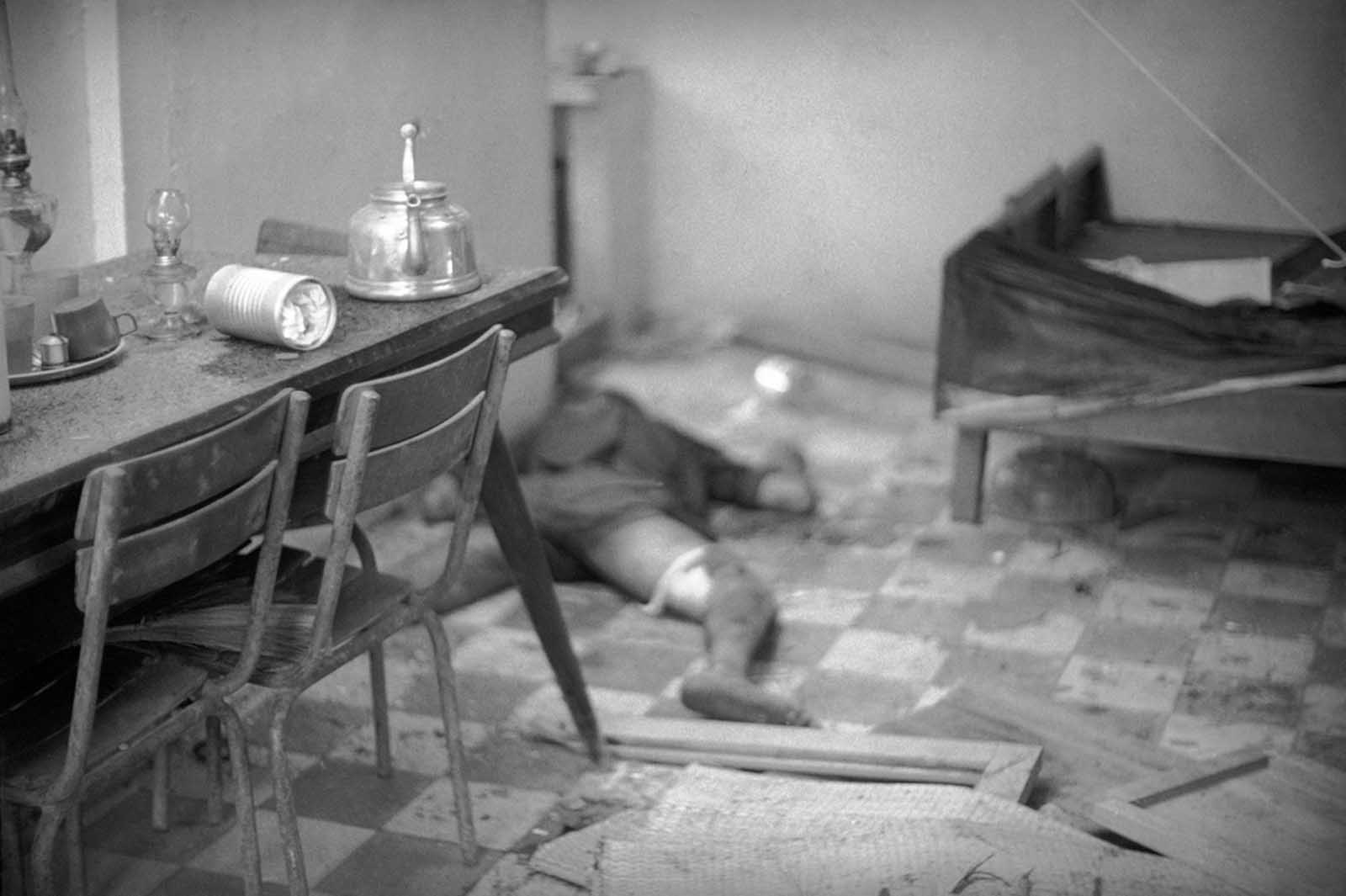
Evidence of violence in the second offensive of the Vietnam War, north of Saigon, in May of 1968.

A U.S. trooper runs past a burning building in Saigon in June of 1968.

U.S. President Lyndon B. Johnson listens to a tape recording from his son-in-law Captain Charles Robb at the White House on July 31, 1968. Robb was a U.S. Marine Corps company commander in Vietnam at the time. Robb was later awarded the Bronze Star and, after returning home, became governor of Virginia in 1982, and later a senator for the same state.

Two napalm drops explode just outside Katum, a U.S. Special Forces camp about 60 miles northwest of Saigon on August 28, 1968. The napalm was used when Viet Cong attacked the camp.

A U.S Marine with several days of beard growth sits in a helicopter after being picked up from the landing zone near Con Thein on the southern edge of the demilitarized zone in South Vietnam on July 18, 1968. His unit had just been relieved of duty after patrolling the region around the DMZ.

Flying 100 feet above the jungle hills west of Hue, five bulky C-123 “providers” cut loose a spray of chemical defoliant on August 14, 1968. The planes are flown by U.S. air force crews who have nicknamed themselves the “ranch hands.” The aircraft are specially equipped with huge 1,000-gallon tanks holding 11,000 pounds of herbicide. U.S. planes dropped millions gallons of chemical defoliant on Vietnam over the course of the war.

Marines prepare their 105-mm Howitzers for action at the end of a day in which this dense jungle area west of Hue was chopped down and molded into a fire-support base for a sweep of the area on February 18, 1969. Troops used explosives and earth-moving equipment to carve out the gun pits and bunkers which by nightfall became a fire-support base.

A Cobra helicopter gunship pulls out of a rocket and strafing attack on a Viet Cong position near Cao Lanh in the Mekong Delta on January 22, 1969. Large craters caused by air and artillery strikes brought in on the area can be seen near the white explosion.

FBI agents carry Vietnam War draft resister Robert Whittington Eaton, 25, from a dwelling in Philadelphia on April 17, 1969, where Eaton had chained himself to 13 young men and women. The agent leading the way pushed one of the group who tried to block path to the sidewalk. At least six young persons were taken away with Easton.

A trooper of the 101st Airborne Division attempts to save the life of a buddy at Dong Ap Bia Mountain, near South Vietnam’s A Shau Valley on May 19, 1969. The man was seriously wounded in the last of repeated attempts by U.S. forces to capture enemy positions there.
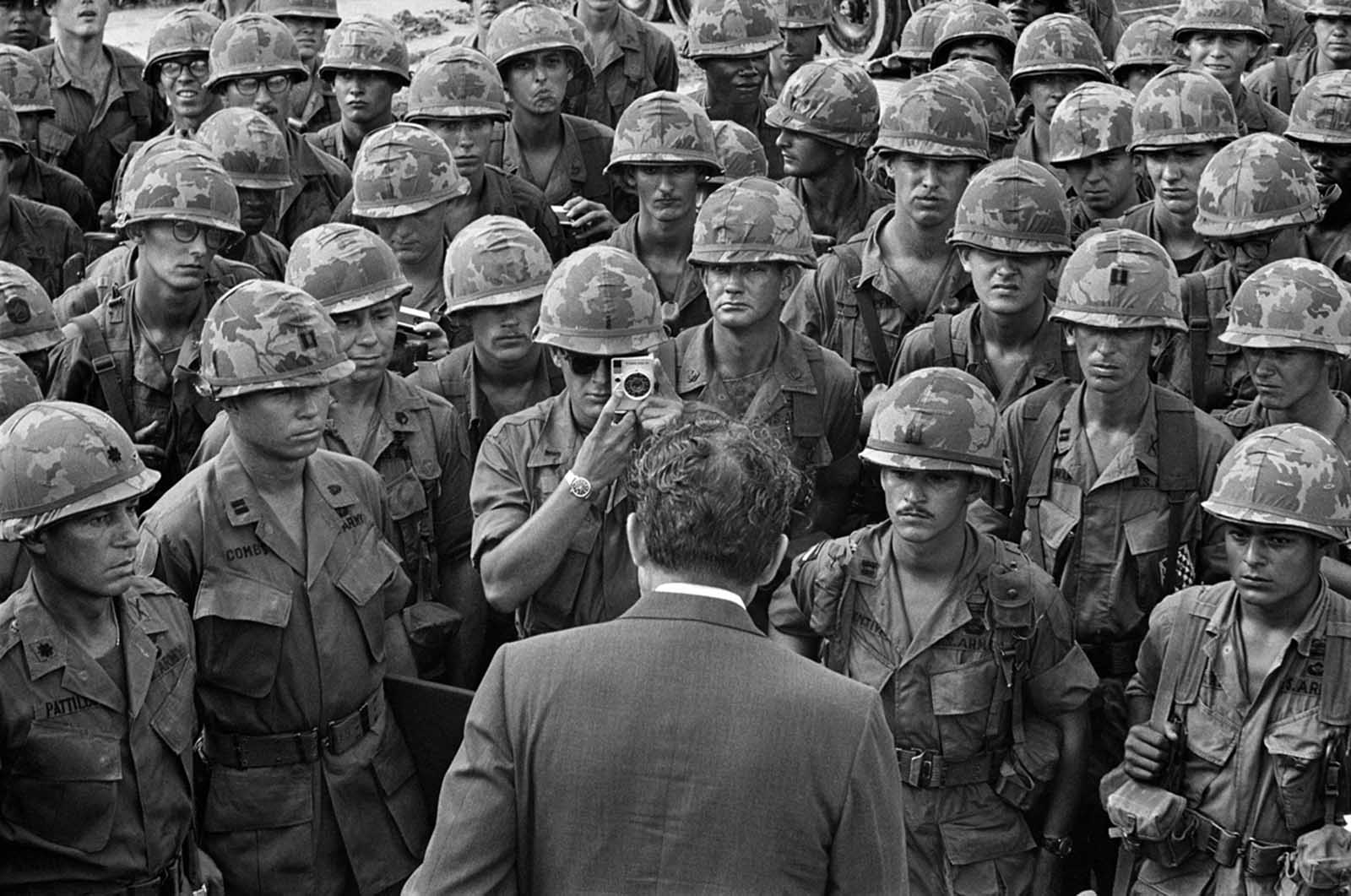
A GI gets a closeup photo as President Nixon meets with troops of the 1st Infantry Division at Di An, 12 miles northeast of Saigon, on his eighth visit to South Vietnam and his first as president, on July 30, 1969.

Marine Lance Corporal David L. Cruz tunes into the latest news on the Apollo moon shot on a helmet-mounted transistor radio while standing guard at Da Nang’s Marble Mountain, on July 17, 1969. In the background is a tall Buddhist figure found in many limestone caves of the mountain.

Demonstrators listen to a performer in Central Park on Moratorium Day, October 15, 1969. Moratorium Day was a mass demonstration and teach-in staged across the United States, in protest against continued American involvement in Vietnam.

Three shirtless U.S. soldiers advance through the Mimot rubber plantation in the Fishhook region of Cambodia, on May 4, 1970, taking aim at a fleeing suspect. The rubber plantation, one of the largest in Indochina, had been in operation until just a few days earlier.

Vietnamese and Cambodian refugees crowd a U.S. helicopter which evacuated them from the immediate combat zone of the U.S.-Vietnamese incursion into Cambodia on May 5, 1970. They were taken to a refugee reception center at the Katum Special Forces camp in South Vietnam, six miles from the Cambodian border.

The Ohio National Guard moves in on rioting students at Kent State University in Kent, Ohio, on May 4, 1970. Four persons were killed and eleven wounded when National Guardsmen opened fire.
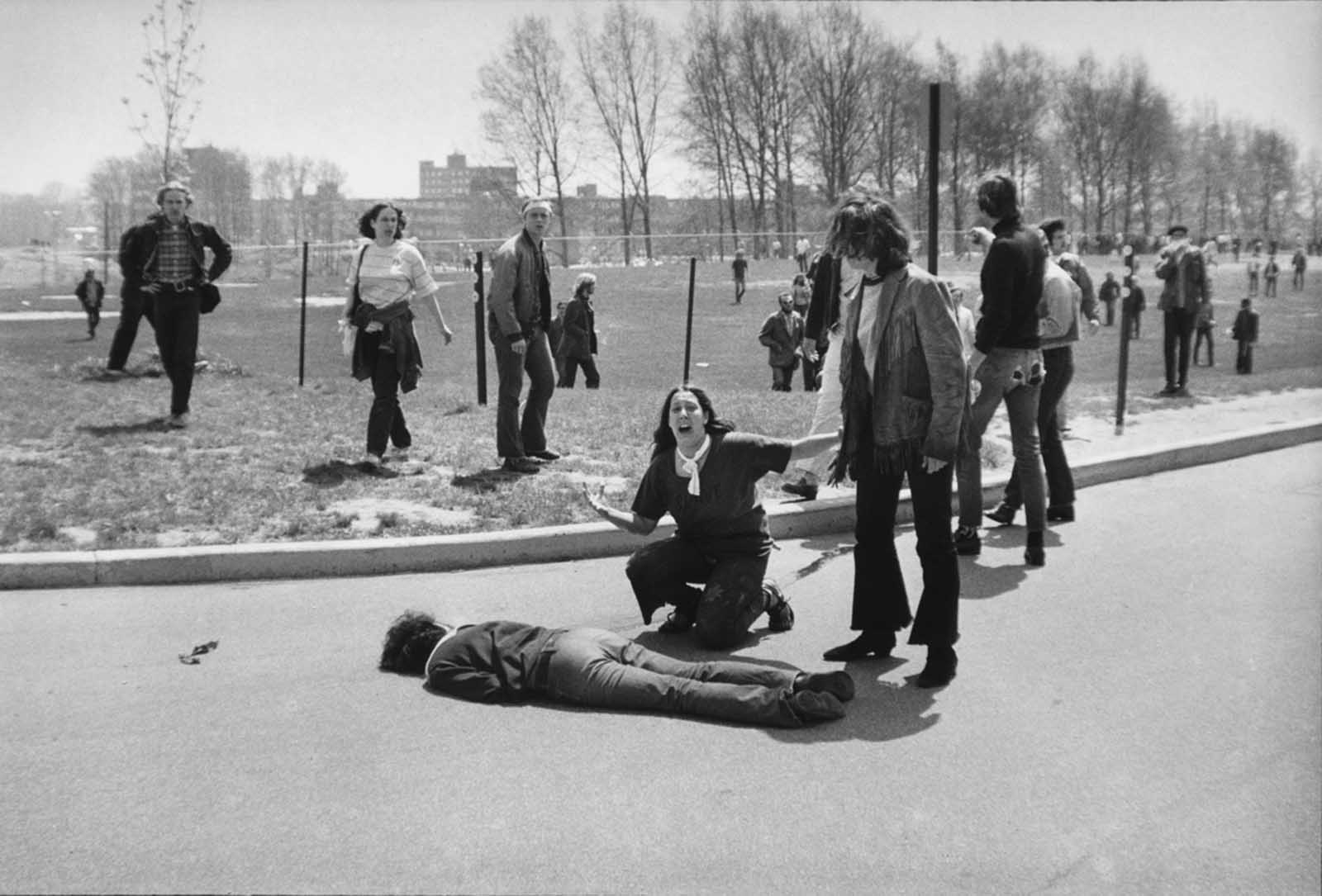
Fourteen-year-old Mary Ann Vecchio screams over the body of 20-year-old Kent State student Jeffrey Miller after he was shot by the Ohio National Guard during a protest against the U.S. invasion of Cambodia during the Vietnam War on May 4, 1970.

In this photo taken from video, soldiers in fire-support base Aries, a small clearing in the jungles of War Zone D, 50 miles from Saigon, smoke marijuana using the barrel of a shotgun they nicknamed “Ralph,” to get high on November 13, 1970.

U.S. artillerymen relax under a crudely made peace flag at the Laotian border in 1971. The gunners were giving covering fire for South Vietnamese troops operating inside Laos.

South Vietnamese troopers test fire flame throwers mounted atop APCs prior to moving out on operation west of Krek, Cambodia, on November 28, 1971.

Bombs with a mixture of napalm and white phosphorus jelly dropped by Vietnamese AF Skyraider bombers explode across Route 1, amid homes and in front of the Cao Dai Temple in the outskirts of Trang Bang, on June 8, 1972. In the foreground are Vietnamese soldiers and news and cameramen from various international news organizations who watch the scene.
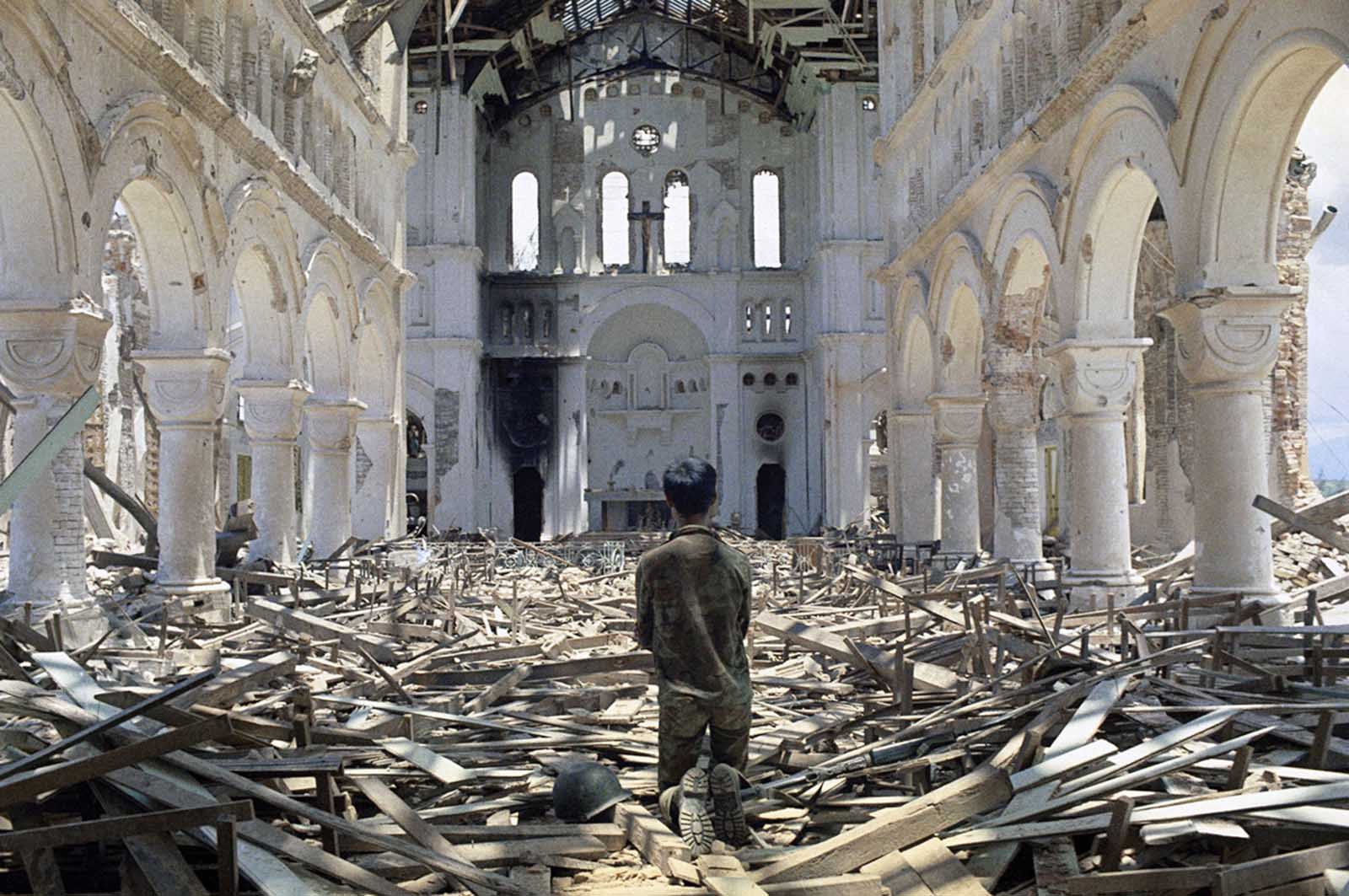
La Vang, town south of Quang Tri City, on July 6, 1972.

A beheaded statue of an American soldier stands next to a bombed-out theater near the district town of Cu Chi, northwest of Saigon, on December 13, 1972. The statue was placed by troops of the U.S. 25th Infantry Division before they were withdrawn from Vietnam two years earlier. Its head was lost in the explosion that destroyed the theater in background.

A South Vietnamese widow cries as a bell at a Saigon Buddhist pagoda tolls the ceasefire at 8 a.m., on Sunday, January 28, 1973, Saigon time. The United States had begun drastically reducing forces in the country, and, following the Paris Peace Accords of 1973, the last remaining American troops withdrew in March of 1973.

A young South Vietnamese woman covers her mouth as she stares into a mass grave where victims of a reported Viet Cong massacre were being exhumed near Dien Bai village, east of Hue, in April of 1969. The woman’s husband, father, and brother had been missing since the Tet Offensive and were feared to be among those killed by Communist forces.

A bon voyage banner stretches overhead in Da Nang, South Vietnam, as soldiers march down a street following a farewell ceremony for some of the last U.S. troops in the country’s northern military region, on March 26, 1973.

The released prisoner of war Lieutenant Colonel Robert L. Stirm is greeted by his family at Travis Air Force Base in Fairfield, California, as he returns home from the Vietnam War, March 17, 1973. In the lead is Stirm’s daughter Lori, 15; followed by son Robert, 14; daughter Cynthia, 11; wife Loretta and son Roger, 12. This famous photo, also called “Burst of Joy,” won a Pulitzer Prize in 1974. The happy scene depicted here was not to last, however. Stirm, after spending five years in captivity, had received a “Dear John” letter from his wife Loretta, just three days before returning home. They divorced in 1974. Read more about this picture.

A refugee clutches her baby as a government helicopter gunship carries them away near Tuy Hoa, 235 miles northeast of Saigon on March 22, 1975. They were among thousands fleeing from recent Communist advances. With U.S. forces out of the country, North Vietnamese troops tested South Vietnamese defenses (and the willingness of the U.S. to return to the fight) starting in 1974, and began capturing territory.

The Fall of Saigon. Fleeing advancing North Vietnamese forces, mobs of South Vietnamese civilians scale the 14-foot wall of the U.S. embassy in Saigon, April 29, 1975, trying to reach evacuation helicopters as the last Americans departed from Vietnam.

A cluster of South Vietnamese marines, some of whom unable to swim, hold onto inner tubes and empty plastic containers as buddies throw them a line to pull them aboard a navy LST off China Beach at Danang as they fled the port city in April of 1975.

A North Vietnamese tank rolls through the gate of the Presidential Palace in Saigon, April 30, 1975, signifying the fall of South Vietnam. The Socialist Republic of Vietnam was formed in 1976, uniting North and South. Millions of South Vietnamese were sent to reeducation camps, millions more fled the country on their own, leading to the Indochina refugee crisis that lasted another quarter of a century.
(Photo credit: U.S. Navy / AP / Library of Congress).